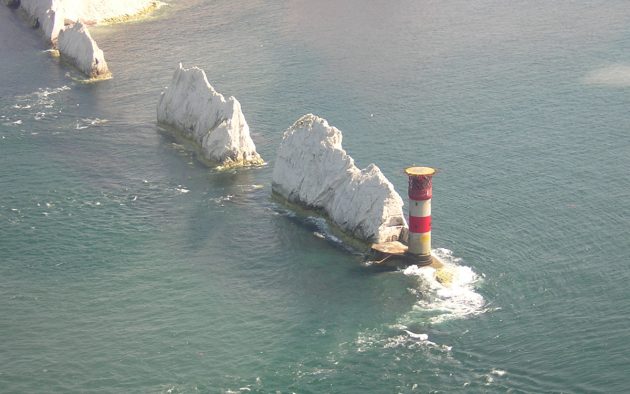Pro navigator Mike Broughton explains how tidal streams can give racing sailors a lot of free information
Navigators need to have a close knowledge of tidal streams and currents. The latest studies show just how multifarious even mid-ocean currents are. Closer to the coast, matters of fluid dynamics get more complex and it is important to be able to simplify what is happening and use tidal streams to our advantage.
When on the water, knowing what the tidal stream is doing right now is a start and it is easy for people to miss basic clues. Every single time you see a buoy or lobster pot, take in the ‘free info’ it is offering on tidal stream. Even if the tide is slack, it is useful to know.
It takes a little time, but it’s useful to calibrate your eye to be able to look at the tidal stream flowing past a buoy and know the difference between, say, 1.5 knots and 2.5 knots of flow. For racers, every time you go to get your start transits next to the committee boat, remember to look down at the flow of water next to the anchored vessel.
Another way of gauging the tidal stream is to look at the way other boats are moving in comparison to their background. Watching how another yacht is sailing upwind relative to a distant shoreline can give you a vital clue. If she is seemingly crabbing sideways to windward when beating, then we have a windward-going tidal stream.
Prior to departing a mooring or marina it helps to always look down and see what the flow of water is doing. If at anchor look at the way other yachts are lying, remembering that the bigger the vessel the more likely it is lying to the tidal stream (unless you are at slack tide). You can see the direction of tide very clearly in some locations, for example by looking at vessels at anchor in the eastern Solent whilst sailing off Cowes in the central Solent.
Tide plotting software
Navigation software can be a great help, particularly when sailing with no land around. Some programmes allow you to plot a useful graph of tide set and direction. You can also get a read-out on a ‘data bar’, which is best used when the tide or current data is averaged over, for example, the previous five minutes.
Even just comparing boat speed and SOG, and heading and COG gives you a clear indication; though remember the information is only as good as your instruments are calibrated.
Just looking at the waves can reveal the presence of tidal streams. Clues come from the angle of the wavelets or whole waves relative to the wind, or by looking at a wider patch of water, most obvious when it appears as a ‘moving carpet’. Looking at the way bubbles or spume move relative to the wind also helps identify current or tidal stream.
Waves tend to be steeper and sharper with wind against tide and you only need about three knots of current against 25 knots of wind to kick up very nasty waves.
Most of the rogue wave areas are due to wind against current. Some of the worst are the waves off South Africa with a strong westerly wind blowing against the notorious Agulhas Current, which flows like a river from Madagascar around the south of South Africa and into the teeth of Southern ocean winds.
In 2015 an Agulhas array was set up off Port Elizabeth to monitor the effects of this fast moving current, which gets totally redirected eastwards in the Southern ocean while some of its eddies spin off north west into the Atlantic ocean and have recently been shown to eventually combine and modulate with the Gulf Stream.
Strong currents against gale force winds create very steep waves and even help create ‘rogue waves’. Rogue waves have smashed the bridge windows of two cruise ships off Cape Horn in recent years and have been the subject of several studies to try and determine their formation and frequency.
Article continues below…
Agulhas Current explained: What it is and how it affects Indian Ocean sailors
On any round-the-world cruise by the sunny route, there is the dilemma of how to cross the Indian Ocean. For…
What is a rogue wave and is it possible to predict where and when one will strike a yacht?
The first oceanographer to define a wave as ‘freak’ was Laurence Draper, a man who preferred to do his science…
Wind-over-tide waves
In years with a strong east Australian Current flowing south into strong south-westerly winds in the Bass Strait, waves can be very steep indeed on the Sydney Hobart race. Even close inshore, tidal streams can create very nasty waves and should not be underestimated. Off the south coast of England, south-westerly winds of ‘only’ 25 knots in the needles Fairway can kick up dangerous steep waves of over 5m when a spring ebb tide is running.
It is also useful to know where we are likely to encounter weaker currents, such as in shallow water where the seabed causes extra friction to slow the flow. Less obvious are areas that create a current or tidal shadow. One area is illustrated in the above picture of the tidal flow past the Needles.
Here we can see a spring flood tidal stream, showing acceleration past the lighthouse and in between the chalk needles, but slack tide in the lee of the first needle where there is even an eddy running against the strong flood tide.
 About the author
About the author
Mike Broughton has been a pro navigator for 25 years and currently races on yachts such as the 107ft superyacht WinWin. He also races and cruises on his own Swan 48, Assuage, and carries out race tuition and navigation masterclasses.






